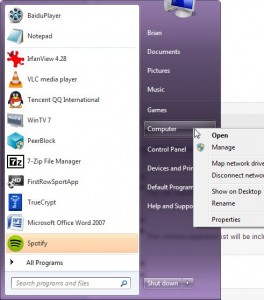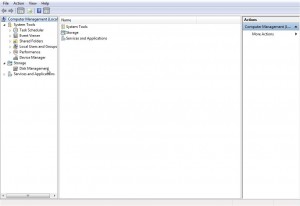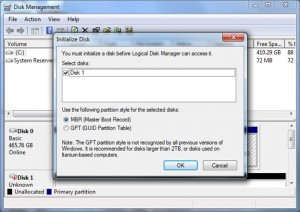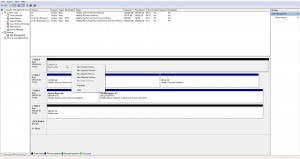We added two new hard drives to one of our computers this week. It had two drives already but we wanted to install Windows 8 and decided that a new drive would be a good thing to add. We had a 2 terabyte drive ready to install then we and a 3 terabyte to the collection. That gave us four, one for Windows 7, another for Windows 8, one for Linux Ubuntu (already installed) and the last one as a spare for storing important files.
Before we could partition the drives, we had to initialize them. What does that mean? Contrary to popular belief, it does not mean ‘formatting’. Let’s say someone gives you a book. There is nothing on the outside of the book to tell you what it is. Therefore you have to look inside it to see what it is. You ‘initialize’ the book when you look inside. Now, that book has nothing in it but once you open it, you know it has nothing in it. At this point you recognize that book as a book with nothing in it. This is a rough description, of course. In reality Windows puts its own little notes on the drive so it will know what that drive is. There are two types of notes that Windows uses. Here’s how to figure it all out.
1. Add the new drive to your computer. That part is quite simple but if you have a problem with it, enlist the aid of a techie friend.
2. Start your computer and, once it’s booted up, click on the start button the look for the word Computer. Right click Computer and choose Manage. This is what this all looks like:

2. When Computer (used to be My Computer) opens, look for Disk Management down on the lower left:

3. Windows will take a few moments to think about your request then, when it sees that one or two drives are not initialized, you’ll see this menu:

4. We installed two drives at the same time. As it turns out, we could use the MBR partition style for one drive but not the other. Remember that one drive was 2 terabytes while the other was 3 T? MBR only works for drives smaller than 2 Terabytes or for partitions smaller than 2T. Since we wanted a full 3 T partition on one drive, which would allow Windows 8 to do what it wanted to the drive on installation, we opted for GPT on the larger drive.
5. We could use GPT on both drives, keep that in mind, so your choice might be just to opt for GPT right from the start. Unless you are using Windows XP, you are quite safe using GPT. No worries.
6. Once you initialize your drive, this is what you’ll see:

Across the top you’ll see that two of the drives are unformatted but Windows knows what they are and tells you the size, etc. Down in the middle, you can right click and choose what kind of volume you want. Since there are a number of options, we’ll leave that for you to investigate. We might do another post on that later on but, for now, we’ll leave this as it is.
TIP: If you’re starting out with a new computer, a new drive and a new installation of your operating system, that operating system will take care of all of this.
How did we get into this? We tried to install Windows 8.1 on one of the new drives. During the early stages of the installation we saw a message that we’d never seen before, and we’ve installed Windows at least 50 times over the years, maybe more. At that point we thought that if we initialize the disks, Windows would install itself on one of the new drives. We were wrong.
We’ll give Windows 8 a shot next to see if it works but at least we were able to teach you about initialization, right? If you have questions, make a comment below and we’ll answer it as soon as we can. Better yet, like our Facebook page and you can ask us on it. Here’s the link: Computers Made Simple on Facebook.
Thanks for reading!
